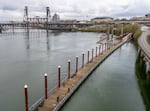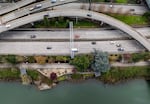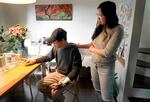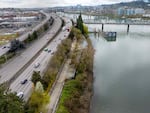
Bike riders and pedestrians on the Vera Katz Eastbank Esplanade in Portland, March 26, 2024.
Kristyna Wentz-Graff / OPB
The Vera Katz Eastbank Esplanade has offered Portlanders a place to walk, bike, jog, and take in views of downtown from the east side of the Willamette River for more than two decades. But lately, it’s attracted a different type of activity: Violent crime.
In the span of two weeks in March, three people were assaulted along the esplanade. Two died from their injuries. Portland police say the attacks are unrelated, yet their shared proximity has raised alarm that one of Portland’s renowned public spaces is unsafe.
The trend could cause some to avoid the path. But law enforcement, urban planners and others agree that the best solution to the safety fears lies in showing up.
“People that love the esplanade, they need to return to it,” said local landscape architect Carol Mayer-Reed. “I think the best thing we can do is embrace it, and then we’ll have better outcomes.”
The esplanade opened to the public in 2001 to create a complete pedestrian and bicycle loop around downtown Portland’s waterfront. The 1.5-mile park, maintained by Portland Parks & Recreation, starts at the base of the Hawthorne Bridge as a paved path carved into the riverbank, then transitions into a floating walkway before ending at the Steel Bridge to the north. The path then crosses the river to connect to the Tom McCall Waterfront Park on the west side.

The Vera Katz Eastbank Esplanade, a bicycle and pedestrian path along the east side of the Willamette River, bottom, seen here just north of the Morrison Bridge, March 26, 2024 in Portland, Ore.
Brooke Herbert / OPB
Mayer-Reed was the lead architect. She said the original plan incorporated public safety by prioritizing lighting and trail maintenance and building in many access points to allow first responders to reach the path in case of emergency. But there was one safety factor that architects couldn’t control: Visitors.
“The presence of more people makes it feel safer,” Mayer-Reed said.
In 2020, foot traffic in Portland’s “central city” — a geographic area spanning downtown Portland and the central eastside — plummeted 70% below pre-pandemic levels. That trend is slow to recover. By mid-2023, foot traffic in the central city had risen to just 23% lower than the pre-2020 calculations. Bicycle use in the central city has also yet to bounce back to pre-pandemic levels. Mayer-Reed worries that the dip in visitors impacts the path’s safety.
It’s a common urban design principle: More eyes on the street and the physical presence of others create a safer neighborhood. Matthew Gebhardt, a professor of urban studies and planning at Portland State University, described a kind of “natural surveillance.”
“Fewer eyes on the space [creates] a circumstance where you may have more opportunity for criminal activity,” Gebhardt said.
He compared the esplanade to the pedestrian path in Tom McCall Waterfront Park, on the other side of the river. The westside path is closer to bustling city activity — like restaurant patios, shops and busy streets — than the esplanade, which is largely shielded from the central eastside’s business and residential district.
“There’s these big, empty parking lots, and then the barrier of I-5, that puts distance between the path and the neighborhood,” he said. “You lose that natural visibility.”
Visibility played a factor in at least one of the March attacks.

Xinmin Liang, 73, left, and his daughter Jie Liang, right, at Jie Liang’s Northeast Portland home, March 26, 2024. Xinmin Liang was attacked as he fished near the Vera Katz Eastbank Esplanade in Portland on March 13, 2024, and suffered a concussion and broken arm.
Kristyna Wentz-Graff / OPB
Jie Liang’s 73-year-old father, Xinmin, was fishing off the esplanade on a cloudy Tuesday morning when he was attacked. Xinmin, who immigrated to the United States from China in 2015, has fished in the area regularly since 2020.
“That’s his favorite spot,” Jie said. “It doesn’t occur to him that the place is not safe. It never came across his mind.”
Xinmin doesn’t ordinarily fish alone. He usually sees other people fishing, walking and sitting on the esplanade. But the path was vacant that day. A man in a blue beanie ran at Xinmin with a large log. Xinmin put his arms up to protect himself. The impact from the log gave him a concussion and broke his arm badly enough to require surgery. After hitting Xinmin, the man ran off. Xinmin doesn’t speak English and rode mass transit home to his downtown apartment before getting someone to help him call 911.
Portland police have yet to arrest a suspect in the assault. Jie wants the case to be investigated as a hate crime, but she was told by officers that it would be hard to prove without any witnesses.
Another March assault, which took place on an early Friday afternoon near the Steel Bridge, is similarly inconclusive. After police arrested a suspect for stabbing another man to death on the pedestrian path, prosecutors said they lacked enough evidence to charge the suspect and let him go.
Jie said her dad won’t be returning to his fishing spot for a while. She wants to see more police officers patrolling the esplanade to improve safety.
“If the city wants people to enjoy public spaces safely, we have to put things in measure to make people feel safe,” she said.

Xinmin Liang, is recovering at his daughter’s home, March 26, 2024, from a concussion and surgery to repair his arm, broken in three places.
Kristyna Wentz-Graff / OPB
According to the Portland Police Bureau, these patrols are already happening.
“And it should not surprise anyone that they’re going to see more police officers patrolling in that area,” said PPB spokesperson Kevin Allen. “But we’re always there.”
Rangers with Portland Parks & Recreation also walk the esplanade daily to keep an eye on the path.
But Allen said that it’s not law enforcement’s responsibility alone to keep the esplanade safe. He pointed out that, in the second deadly assault on March 22, several members of the public intervened to try to stop the attack and call 911. According to court records, the suspect only dropped the rock he was using as a weapon after a security guard used a taser on him.
“The fact that we’ve got community members who are willing to step forward and try to address a crime that’s happening in front of them, that really shows that this is a holistic solution,” Allen said. “Public safety isn’t just about the police.”
The suspect in that case has been charged with murder in the second degree.
Despite the recent assaults, people who spend the most time near the esplanade say they feel safe.
“It’s a pretty good atmosphere down here, normally,” said a man named Niles, who has slept in a tent under an overpass near the esplanade for the past three weeks. “I’ve met a couple of really nice people, you know, biking and enjoying the scenery.”

Niles stands in his structure near the Vera Katz Eastbank Esplanade in Southeast Portland in March 2024. Niles says he's never felt unsafe at the park, despite a number of recent attacks.
Alex Zielinski / OPB
He is familiar with other people sleeping outside in the vicinity and said they all “keep an eye out” for each other and any commotions along the path. He doesn’t know anything about the recent attacks and worries that they’ll be blamed on people camping near him. Niles said police who were investigating the most recent homicide told him he needed to relocate.
“It’s too bad, because I feel safe staying here,” Niles said. “That isn’t always the case on the streets. We don’t really have many places to go, and down here it’s beautiful and it’s out in the open.”
Niles said he often sees joggers and bicyclists using the path, but he believes there is potential for more people to enjoy the esplanade.
“I’m surprised there aren’t more things going on down here,” he said.
Mayer-Reed, the esplanade architect, agrees. She said the area could benefit from more events that familiarize people with the waterfront path. She fondly recalled the day the esplanade opened in 2001 when the celebration included live music and aerial acrobats at the base of the Hawthorne Bridge.

The Vera Katz Eastbank Esplanade, a bicycle and pedestrian path along the east side of the Willamette River, right, looking south towards the Hawthorne Bridge, March 26, 2024 in Portland, Ore. Interstate 5 is on the left.
Brooke Herbert / OPB
“I would encourage our arts community to think about it as a venue,” said Mayer-Reed. “Just like the [Tom McCall] Waterfront Park.”
She also encouraged the city to allow food vendors to operate on the path as another tool to attract new visitors. And she wants to see more city staff patrolling the paths to add another layer of security to the area. But she acknowledged that it’s not the responsibility of the local government alone to strengthen public safety along the esplanade.
“I think we need to turn a positive eye toward asking, you know, ‘What can I do? What can the citizens do?’” she said. “We shouldn’t necessarily just depend on the city to do everything. How can we be investing in our own future for ourselves and our families?”
